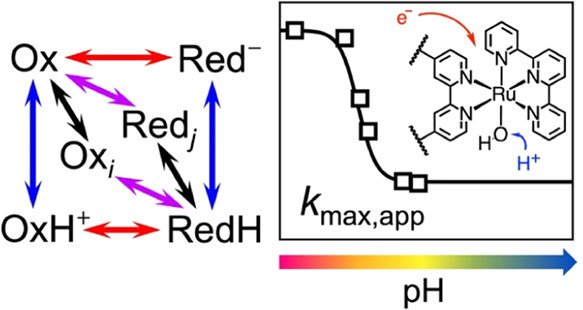General Kinetic Model for pH Dependence of Proton-Coupled Electron Transfer: Application to an Electrochemical Water Oxidation System
The pH dependence of proton-coupled electron transfer (PCET) reactions, which are critical to many chemical and biological processes, is a powerful probe for elucidating their fundamental mechanisms. Herein, a general, multichannel kinetic model is introduced to describe the pH dependence of both homogeneous and electrochemical PCET reactions. According to this model, a weak pH dependence can arise from the competition among multiple sequential and concerted PCET channels involving different forms of the redox species, such as protonated and deprotonated forms, as well as different proton donors and acceptors. The contribution of each channel is influenced by the relative populations of the reactant species, which often depend strongly on pH, leading to complex pH dependence of PCET apparent rate constants. This model is used to explain the origins of the experimentally observed weak pH dependence of the electrochemical PCET apparent rate constant for a ruthenium-based water oxidation catalyst attached to a tin-doped In₂O₃ (ITO) surface. The weak pH dependence is found to arise from the intrinsic differences in the rate constants of participating channels and the dependence of their relative contributions on pH. This model predicts that the apparent maximum rate constant will become pH-independent at higher pH, which is confirmed by experimental measurements. Our analysis also suggests that the dominant channels are electron transfer at lower pH and sequential PCET via electron transfer followed by fast proton transfer at higher pH. This work highlights the importance of considering multiple competing channels simultaneously for PCET processes.
Cui, K.; Soudackov, A. V.; Kessinger, M. C.; Xu, J.; Meyer, G. J.; Hammes-Schiffer, S. General Kinetic Model for pH Dependence of Proton-Coupled Electron Transfer: Application to an Electrochemical Water Oxidation System. J. Am. Chem. Soc. 2023, 145 (35), 19321–19332. https://doi.org/10.1021/jacs.3c05535

